
Although they may have followed the advice in ancient health manuals such as the Babylonian Code of Hammurabi, written in the 18th century BC, which included instructions for the use of herbs, ancient peoples also believed illness to be the vengeance of the gods and the work of evil spirits. Such spirits were thought to be deterred by a beautifully decorated body. Early cosmetics, such as the kohl around the eyes of Egyptian women, also helped to protect them from the sun and keep diseases at bay.
As medical knowledge advanced, people found it hard to shake off their belief in the old wives’ tales. By the 19th century there was a huge trade in patent medicines with secret formulas, promising cures for everything from coughs to constipation and corns. Also widely advertised were beauty products for hair and skin, and hinged appliances to replace missing limbs.
While they may not have been correct in every regard it is remarkable how many of the old cures have been discovered by modern medical science to have a sound basis, whether it is the benefits of walking or laughter, that it is wise to stay out of the sun, or that fish is indeed good for the brain.
CARROTS HELP YOU SEE IN THE DARK

This saying, popular in the blackouts of World War II, when carrots were prized for their sweetness as substitutes for sugar, contains more than a grain of truth.
Carrot conserves are still prized as a delicacy in Asia – in contrast to the carrot jam eaten under mild protest in wartime Britain as a poor substitute for marmalade.
Carrots are a great source of beta carotene, the plant form of vitamin A, and it is this vitamin that helps to prevent night blindness by combining with the protein opsin in the retina at the back of the eye to form rhodopsin, the chemical essential for good night vision. Just one carrot a day is all it takes, and unlike many other vegetables carrots are better for you cooked than raw. Cooking breaks down the plant’s tough cell walls, making the vitamin A more readily available for absorption into the bloodstream.
In wartime Britain, the Ministry of Food did its best to drum up enthusiasm for carrots. Doctor Carrot, carrying his bag marked “Vit A,” was pictured on the pages of recipe books promoting such delicacies as carrot puddings. These were nothing new: carrot cakes and puddings have been enjoyed throughout Europe since the Middle Ages, and recipes have been commonplace in cookbooks since the 18th and 19th centuries.
The original cultivated carrot, brought to the West from the Middle East and Afghanistan between the 8th and 10th centuries AD, was purple or very dark red. As paler colors were bred in the 16th century, these dark shades fell from favor, but are now being reintroduced.
WHITE FLECKS ON THE NAILS MEAN YOU’RE SHORT OF CALCIUM
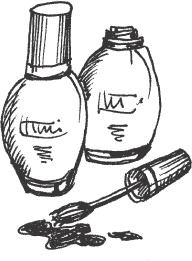
They are more likely to be a sign that your diet is lacking zinc or possibly vitamin A, not calcium. For although calcium is needed for building strong bones and teeth, the nails are made of the fibrous protein keratin, which does not include calcium as one of its major components.
The link between calcium and white nail spots probably comes from the color association – white spots, white mineral. In superstition they are associated with receiving gifts and predicting events, as in Ben Jonson’s play The Alchemist of 1612: “H’is a fortunate fellow, that I am sure on… And, in right way to’ward riches… I knew’t, by certaine spots…on the nayle of his Mercurial [little] finger.”
To get more zinc, the easy way is to take a supplement of 30 mg daily, plus 2 mg of copper, which helps the zinc to be absorbed into the body more easily. Or it could be a good excuse to eat more oysters, which are rich in zinc, as are beef, the dark meat of poultry, liver, eggs and almonds. For men, as well as boosting nail health, zinc will help pep up the sperm count.
The nails can also betray serious disease. White streaks that run down the whole length of the nail can be a sign of heart disease and hollow, spoon-shaped nails can accompany severe iron deficiency. Pitted nails are typical of psoriasis.
DON’T KEEP PLANTS IN THE SICKROOM
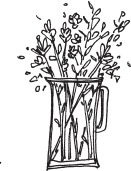
Especially, it was said, at nighttime, for they would rob the room of vital oxygen. It is true that in darkness plants reverse their daytime activity of absorbing carbon dioxide and releasing oxygen but it would take more than a couple of vases to seriously affect the quality of the air.
To prevent disturbing patients with unnecessary noise, maids were taught to use a gloved hand for putting coals on the fire, or to wrap lumps of fuel in newspaper.
Modern nurses have far greater concerns than removing plants from hospital wards at night, and plants and flowers are banned from hospital wards as potential carriers of antibiotic-resistant bugs. However our grandparents made much of the sickroom, which was entirely understandable in an era before the advanced antibiotics and inoculations that now cure or prevent so many illnesses.
The air of the sickroom was also likely to be polluted – at least in winter – by the fumes from a coal fire. However it was recommended that, except for patients suffering from chest and kidney complaints, the windows were “opened wide after the action of the bowels.”
It was considered essential for the old-fashioned sickroom to be cleaned and dusted every day, and the patient washed all over. For infectious illness, a sheet soaked in a strong and smelly solution of carbolic or the disinfectant Lysol, made from coal tar, was hung over the bedroom door and kept permanently damp.
FRESHEN GARLIC BREATH BY CHEWING PARSLEY
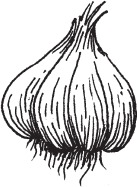
The cook’s favorite garnish is also one of the herbalist’s traditional remedies for bad breath. Parsley stalks, rather than the leaves, will have the best effect, because they contain more of the plant’s volatile oils.
Garlic is so potent on the breath because it is packed full of pungent sulfur-containing oils. These are carried in the blood to the lungs, released and breathed out through the mouth. In addition, smelly substances including hydrogen sulphide – the gas with the smell of bad eggs – are made from food remains by bacteria that live between the papillae, the tiny lobes in the tongue. Brushing or scraping your tongue when you brush your teeth are ways of keeping these bacteria at bay.
Not sure whether your breath is offensive? An old-fashioned test is to lick the back of your hand, let it dry for a few seconds and sniff it. If it smells bad, then so does your breath.
Like other natural breath fresheners such as aniseed and peppermint, parsley will only mask offensive odors from foods like garlic and onions, or from drinking too much wine or beer, and will not cure the underlying effects of halitosis. If bad breath persists in the absence of garlic and its sulfurous relatives, it may be your teeth or gums that are the problem, or a persistent digestive ailment – for which parsley itself is a long-used herbal remedy.
Chewing garlic was once said to stop competitors getting ahead in races – as well as warding off vampires. Today, allicin, the chemical that gives fresh garlic its smell, is being used in hospitals to help fight “superbugs” resistant to antibiotics.
SOOTHE TIRED EYES WITH CUCUMBER
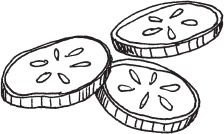
The coolness of cucumber slices on closed eyelids is undoubtedly relaxing, but lying down with your contact lenses out and your eyes shut is probably as good for you as the vegetable you put on them.
The eyes get tired when you stare repeatedly at the computer screen or the pages of a book because the small muscles that control the shape of the lens and assist with focusing become fatigued. Your eyes can also get dry if you don’t blink enough – blinking helpfully spreads lubricating fluid, the tear film, across the front of the eyeball. Central heating and air conditioning, which sap the air of humidity, add to the problem, but persistently tired eyes need the attention of the optician to rule out any serious underlying condition.
Cucumbers were grown and eaten by the Greeks and Romans and were esteemed by Nicholas Culpeper, who wrote in The English Physician Enlarged (1653): “The face being washed with their juice cleanses the skin.”
The eye bath was essential to the Victorian medical cabinet and washing the eyes with a salt water solution was a popular remedy. In the 1920s and 1930s the pharmacist would have made up a weak solution of zinc sulfate as a cure for tired eyes. This was the recommended routine for using the eye bath: “It is filled with lotion and the patient bends forward the head and applies the edge of the bath firmly around the eye. He then throws his head back and opens the eye widely. The lotion is kept in contact with the eye for a minute or two. The cleansing may be facilitated by opening and closing the eye several times…”
Plain cold water soaked into a clean facecloth may work as well as anything to perk up tired eyes (cucumbers are cool because they contain 95 percent water) but herbalists also recommend bathing the eyes with an infusion of marigold petals or eyebright.
ROSEHIP SYRUP KEEPS COLDS AT BAY
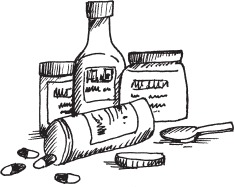
This may be effective if you believe that mega doses of vitamin C are the best way to control the cold virus. Weight for weight, rosehips gathered from the dog rose (Rosa canina) actually contain over 20 percent more vitamin C than oranges.
The idea of averting colds with doses of up to 10 grams a day of vitamin C was first advocated by the American Nobel laureate Linus Pauling in 1970. Counter to this, the latest research suggests that vitamin C reduces the duration of the symptoms rather than actually stopping a cold from occurring in the first instance. The other bad news is that there is virtually nothing that can stop the cold virus. But it’s worth avoiding anyone who has just caught a cold, as the first three days of the illness are when a person is at their most infectious.
Even if it doesn’t stop a cold, the vitamin C in rosehip syrup has lots of other health advantages. It fights the damage caused by “free radicals” – unstable oxygen molecules – especially inside body cells, and in doing so helps to protect against cancer and heart disease.
Rather than high-sugar syrup, rosehip tea is a good way of getting the health-giving vitamins of the hips. It can be made by infusing ½ ounce (15 g) each of dried rosehips and chamomile flowers in 9 fluid ounces (250 ml) of boiling water, then sweetening the liquid with a little honey.
ALWAYS CUT TOENAILS STRAIGHT ACROSS
Still the best way of preventing ingrowing toenails, this is most easily done after a bath or swim when the nails are soft.
When you cut into the sides of a big toenail, the “nail folds” (the skin around the nail) can become swollen, and often painful and infected. Wearing shoes that are too tight can have the same effect – that is, to make the nail dig into the puffed-up skin. Despite the pain, it was known for schoolboys in the 1950s to inflict the problem on themselves to avoid compulsory games and cross-country runs.
At the first sign of an ingrowing toenail, the old-fashioned, painful treatment was to soak the nail in hot water for 10 minutes then raise the corner of the nail and press a piece of cotton wool under it. Today, antibiotics will most likely be prescribed to treat the infection, but scrupulous attention to hygiene is vital. In severe cases, surgery is necessary to remove part of the nail base, from which it grows.
NAIL CUTTING DAYS
For the superstitious, the day of the week on which you cut your nails is crucial, as in this old rhyme:
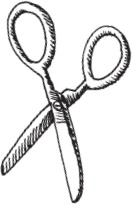
Cut them on Monday,
you cut them for health,
Cut them on Tuesday,
you cut them for wealth,
Cut them on Wednesday,
you cut them for news,
Cut them on Thursday,
a new pair of shoes,
Cut them on Friday,
you cut them for sorrow,
Cut them on Saturday,
you see your true love tomorrow,
Cut them on Sunday,
your safety seek,
The Devil will have you
the rest of the week.
It is, and just as good for your heart – especially oily fish like salmon, mackerel and herrings. Eating fish won’t make you a genius, but will help to keep your whole nervous system in good shape.
What oily fish does best for the brain is to protect it from strokes – interruptions to the blood supply, often caused by blood clots, which kill brain cells and leave victims with anything from a slight paralysis on one side of the body to total loss of both memory and speech. The most effective substances in fish are omega-3 fatty acids, which help to keep the arteries clear. They may also help lift depression and even reduce the risk of dementia.
Latest research suggests that the fatty acids in fish may help recovery from chronic fatigue syndrome by effecting ‘repairs’ in the brain.
All fish benefit the nervous system by supplying good quantities of vitamin B12, and the oily varieties also provide vitamin A (vital for good eyesight) and vitamin D (for strong bones). And everyone can get at least a third of the protein they need each day by eating just 3½ ounces (100 g) of any fish.
A swallowed fishbone can scratch the throat, making it feel as though it is stuck. If a bone is truly stuck, eating poorly chewed bread is a good way of dislodging it. Sipping neat lemon juice may help dissolve a small bone, but one that can’t be shifted needs medical attention.
Eat the Japanese delicacy fugu – raw blowfish – and you could be taking your life in your hands. The skin, intestines, liver and roes contain a lethal toxin. Only fugu chefs specially trained for three years may prepare it, but some Japanese are still fatally poisoned each year.
TREAT A NETTLE STING WITH A DOCK LEAF
Handily, the stinger and its antidote are often found growing near each other, and a bruised dock leaf has been known for generations as the best emergency treatment. It is said to work particularly well if you also chant the rhyme “Nettle out, dock in, dock remove the nettle sting.”
The broad-leaved dock (Rumex obtusifolius) creates its soothing effect because its leaves are rich in oxalates. These chemicals cool the skin, which becomes inflamed when pierced by the minute tips of the stinging hairs on the stinging nettle (Urtica dioica). The tips snap off and lodge in the skin when the leaf or stem is touched; here they release their poisonous load. Among them is histamine, the chief culprit in causing inflammation.
The best way of avoiding stings is to grip a nettle tightly so that the tips of the hairs break off before they have a chance of entering the skin. “Grasping the nettle” has been synonymous with bravery since the 17th century.
The best home treatment for nettle stings is to apply an ice pack, a cool compress soaked in bicarbonate of soda solution, or old-fashioned calamine lotion. If a severe reaction flares up, in which the face swells and breathing becomes labored or difficult, call for emergency medical help.
Nettle stings have long been used as deliberate “counter irritants” to warm the skin and soothe the pain of arthritic joints. It is said that the Romans brought their native nettles to Britain with them to rub on their skins and warm them up in unaccustomed cold climes.

That is water, the world’s first drink, named from the first man, and the fluid vital to life. Its importance is shown in its symbolic use in Christian baptism, named from the Greek baptizein, meaning “to dip in water.”
The adult body, which itself is about 60 percent water, needs water for keeping all its parts well lubricated and for essential tasks such as digestion. And since water is continuously expelled as we breathe, as well as in the other processes of living, it needs to be constantly replaced.
Luckily, most food is also water-rich (we get about a quarter of all the water we need from what we eat, and most of all from fruit and vegetables), but the experts reckon that we should all drink around 4½ pints (2 liters) of water a day just to keep the system topped up, and more if we exercise vigorously and lose water in sweat. Dehydration makes you feel headachy, sluggish and lethargic and can be a precipitating factor in conditions such as kidney stones and urinary infections. To see if you’re drinking enough water, do the “urine test.” It should be pale and clear like a Muscadet wine, not dark in color.
The first water drawn from a well on New Year’s Day was thought, in country districts, to endow good fortune if sprinkled on passers-by. If drunk it was also believed to bring beauty and wealth.
The health-giving properties of the water at spa towns has been long appreciated. Bath, which was developed by the Romans, became a medieval destination for pilgrims in search of healing cures. In Europe, places such as Baden-Baden in Germany and Spa in Belgium became fashionable places to: ”take the waters” from the 16th century.
As for today’s water, hard high-mineral tap water is healthier than soft. And all tap water, as long as it is guaranteed free from bacterial contamination, is as good for you (and your pocket) as bottled water, which can be high in sodium.
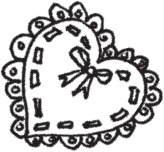
A saying true for the body, if not the soul. When we get cold the circulation in our extremities closes down to protect the inner organs – the heart included – which is why it is possible to survive severe frostbite in both hands and feet.
Like other warm-blooded animals, the bodies of humans are tuned to maintain a constant temperature – in our case 98.4°F (37°C). As soon as our internal sensors register that we are getting cold, our self-protective mechanisms go into action. First we get goose bumps as our hair stands on end in an attempt to improve body insulation. Then we shiver, generating warmth through muscle movement. Simultaneously, blood is diverted to the body’s core, shielding key organs from potentially fatal blood clots and strokes.
If cold hands mean a warm heart, a moist hand is said to betray an amorous nature.
Apart from wearing gloves, exercise to get the circulation going is a good way of keeping the hands warm. Or it can be pepped up with ginger, a spice long renowned for dilating the blood vessels and stimulating the circulation; it tastes especially good mixed with lemon, honey and hot water.
Servants such as scullery maids, with their hands constantly in water, suffered greatly from raw, chapped hands. But in the early 20th century they were advised that: “Vigorous scrubbing with a soft nailbrush when washing stimulates the circulation… For chapped hands, clarified mutton fat, perfumed to liking, is a simple but efficacious remedy.”
In Raynaud’s syndrome the blood vessels in the feet, ears and nose, as well as the hands, may go into spasm when subjected to cold, cutting off the circulation. The extremities go white and numb, and when the spasm eases become red and painful. The problem affects about one person in ten and is much more common in women than men.
Especially if you want to avoid sunburn and, ultimately, skin cancer. Until the 1920s, when the suntan first became fashionable, any woman who considered herself a “lady” would do everything possible to avoid having a reddened or tanned skin like that of a farmworker.
When exposed to the sun the skin reacts by producing extra amounts of the dark, protective substance melanin, but fair skins can easily become burned well before this happens. Cells are probably triggered to become cancerous by the sun’s UVA and UVB rays, especially if the skin has been overexposed to them during childhood.
Get a hat. Headwear with a brim 4 inches (10 cm) wide can cut your risk of skin cancer by up to 40 percent.
Avoiding the sun between 11:00 a.m. and 3:00 p.m., covering up and using a sunscreen with a high protection factor (30 plus, or a total block in the case of fair skin) are the proven ways to cut the risk. Do not forget vulnerable spots such as the lips and the backs of the knees and, if you do burn, apply calamine lotion or aloe vera to help cool the skin and speed healing.
When bicycling became the vogue in the late 19th century, Cycling Hints for Ladies suggested: “A veil [worn over a hat]…as a protection against flies, and to conceal a flushed face,” and “To avoid sunburn, if the skin is delicate, a lady should, before starting, rub glycerine in. If the skin is already affected by the sun, either milk or lemon juice, glycerine or cucumber, or sulpholine lotion is very useful.”
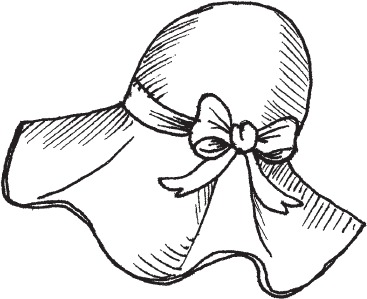
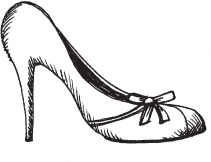
They can, because they shift your center of gravity and in doing so put extra strain on the spine. But for many women there is no confidence booster to beat the stiletto heel.
High heels put the spine out of kilter by transferring the weight forwards from the heels (which bear, together with the hips and backbone, most of the body’s weight) to the toes. Although it helps to have an ankle support to prevent the toes from “clawing” as they try to keep the shoe on the foot, high heels affect some people more adversely than others. Trouble is most likely if the extra height adds an exaggerated curve to your lower spine, making you hollow-backed.
A heel is a man devoid of any sense of honor or decency. The expression is of American origin.
If worn every day of the week, high heels can exacerbate bunions as well as backache, but sometimes only a high heel will do. Late Victorian women were advised that when “the heel is placed exactly in the right spot…and the slipper fits snugly and comfortably…it is no more injurious to wear under these conditions than any other well fitting shoe, and gives a certain elasticity to the carriage of the graceful woman that a flat shoe never does.”
The stiletto, fashion essential of the 1960s, harked back to the French courts of the 17th and 18th centuries, when heels were worn first by men (to add to their height) and then by both sexes. Stilettos are named from the sharp, tapered instrument used for piercing eyelets in leather (the stiletto dagger has a short, thin blade).
KEEP HAIR A NATURAL BLOND WITH CHAMOMILE

An age-old, mild and effective treatment that gives a much more natural look than “raw” peroxide. The favorite herb of Elizabethan gardens, chamomile, also spelled camomile, has a wide range of medicinal uses.
The “Beauty Culture” section of the 1933 News Chronicle Housewife’s Handy Book strongly recommends chamomile for blonds: “Simmer a handful of camomile flowers in a pint of water. Strain through fine muslin and apply to the hair with a small brush, parting hair so that every part is wetted. Leave for twelve minutes or so, and rinse away with warm, soft water.”
The same book is heartily critical of the “peroxide blonde”: “The woman who uses plain peroxide for her hair does a very foolish thing, apart from the fact that peroxide produces such a metallic and unnatural shade that a ‘peroxide blonde’ has become a phrase that expresses the absolutely artificial and undesirable.”
Chamomile comes in many varieties including Chamaemelum nobile, the lawn species, but it is German chamomile (Matricaria recutita) that has been most widely used for centuries to treat everything from digestive disorders and insomnia to fungal skin infections, inflamed gums, sinusitis and asthma. A chamomile poultice was a common country remedy for soothing sprains and strains.
“Gentlemen prefer blondes” became part of the language thanks to the play of the same name written by Anita Laos in 1925. It was cemented into Western culture by the 1953 film musical starring Marilyn Monroe and Jane Russell.
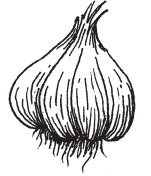
This is not just an old wives’ tale but advice that really works. For colds, chicken soup passes the scientists’ health test too.
Researchers at the Academic Medical Center in Amsterdam have discovered that food (given as a 1,200-calorie liquid meal) boosted blood levels of gamma interferon, a substance we produce to fight viruses such as those that cause colds and flu. But they also found that after fasting for 12 hours there is a rise in blood levels of the protein interleucin-4, a substance made by the antibodies to combat severe infections such as typhoid, which cause high fever.
So is chicken soup the perfect food for a cold? A team working at Nebraska Medical Center found that for people with colds, chicken soup – whether homemade or canned – reduced inflammation and helped to stop noses running by easing the production of excess mucus. Plain vegetable soup with no chicken did not work as well.
News on the exact ingredients in chicken that help a cold are not yet forthcoming, but onions and garlic have long been used to treat respiratory infections. As the herbalist John Gerard recorded: “The juice of onions snuffed up into the nose, purgeth the head, and draweth forth raw flegmaticke humors.”
A fever – the body’s way of coping with a severe infection – is always more serious, especially in children. In the days before vaccinations and antibiotics the hope was always that a patient would “come through” a fever alive, whatever their age.
In the 17th century Jesuit missionaries in South America discovered that the bark of the chinchona tree could lower the fever of malaria. Its active component, the alkaloid quinine, destroys the malarial parasites in the blood, but is highly toxic, even in moderate doses.
EAT A PECK OF DIRT BEFORE YOU DIE
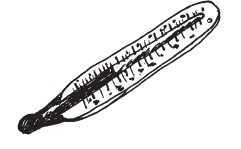
An excuse for lack of hygiene first recorded in the 17th century, but also an expression of life’s imperfections. Medically, a little dirt can be helpful in boosting the immune system. A peck is an old measure for dry goods equivalent to two gallons; it can also just mean a large amount.
Dirt is potentially dangerous because it contains germs such as bacteria or viruses, but if these agents of infection get into the body they have to confront the human immune system. The invaders are engulfed and “eaten” by white blood cells and the body’s lymph nodes are triggered into pouring lymphocytes into the blood. Some of these produce antibodies that inactivate many of the invaders and make them easily neutralized by other white blood cells.
Quarantine, a period of isolation to stop disease from spreading, originated following the Black Death of 1380. Occupants of ships landing near Venice were not allowed into the city for 40 days – hence quarantine from the Italian quaranta.
Other types of lymphocytes congregate at the site of an infection, destroying damaged cells. And lymphocytes of all kinds create a “memory” of the infection, so that if a disease is encountered again it is either quashed completely or is only very mild. Which means that a peck of dirt – as long as it doesn’t kill you – is protecting you from further infections. We are also safeguarded by vaccinations, which stimulate lymphocyte memories for killer diseases such as typhoid, tetanus, smallpox and diphtheria, which were the scourge of previous generations, without making us ill.
Two herbs, goldenseal (Hydrastis canadensis) and echinacea (E. angustifolia, E. purpurea and E. pallida) are herbalists’ favorites for boosting the immune system. Both have a long history of use by native Americans to treat everything from snakebite to stomach ache.
Or rub it with a cut onion, great-grandmother would have said. Unlike a bee, which leaves its sting in the skin (it needs carefully removing with tweezers), the wasp injects its poison then flies off to sting again.
The best wasp sting remedies – lemon juice is another – neutralize the alkalinity of the sting. An ice pack will help calm any swelling. It was once thought that the toxin could travel to and poison the heart. In fact what can be fatal following both wasp and bee stings is anaphylaxis, an extreme allergic reaction in which the air passages swell up and breathing is fatally impaired as a result.
In late summer, wasps in orchards were traditionally trapped in jars filled with beer or sugared water hung in the trees. Enticed to drink, the insects would drown. In the past sulfur was used to fumigate wasps’ nests, but a more humane solution is to leave it until the end of the season, when the colony will disappear anyway, then block off the hole or crevice in which it formed.
Wasps are nature’s paper makers; they chew leaves and wood fibers, mixing them with saliva to make a pulp that they use for nest building. Some South American wasps add soil to the pulp to make nest walls that are as solid as stone.
COUGHS AND SNEEZES SPREAD DISEASES
“Trap the germs in your handkerchief.” So ran the slogan on the British 1942 wartime poster, when food and fuel were scarce and good health at a premium. And beware of touching anything – microbes can easily spread on everything from fingers to doorknobs and pieces of paper.
The germs – bacteria and viruses – that cause disease are forced from the body at high speed in coughs and sneezes, which makes these a simple and effective way for germs to spread from person to person. But the diseases that make us sneeze and splutter, especially colds and flu, are also spread by touch, so as well as avoiding the newly infectious, deter infection by washing your hands, especially if you’ve been handed anything by someone with a cold. If you can, avoid touching your mouth or nose until you have done so.
According to Pliny in his Natural History of AD 77, the first wasp of the year, caught and attached under a patient’s chin, would cure a fever.
The good handkerchief was still much prized when The House and Home Practical Book of 1896 declared: “When it comes to certain accessories of the toilet, notably handkerchiefs, every American woman has cause to regret that she was not born in Paris. The French handkerchiefs are so superior in texture, in ornamentation and so maddeningly cheap in comparison.” However, it continued, “so called fancy handkerchiefs, made of chiffon are…not to be recommended…its adoption as an ornament is not to be sanctioned…”
Coughing is the telltale symptom of consumption – pulmonary tuberculosis – which in the 1890s accounted for three in every 20 deaths of New Yorkers and is still a major cause of death worldwide, mainly in Southeast Asia and Africa. In the course of the disease, blood is commonly coughed up.
EATING YOGURT MAKES YOU LIVE LONGER
A saying that owes its origins to the fact that Georgia and the Smolyan region of Bulgaria, where yogurt is a staple part of the diet, boast large numbers of centenarians. Whether it adds to your lifespan or not, yogurt has some undoubted health benefits.
Whether made from the milk of cows, sheep, goats, camels or even yaks, all yogurt is made by the action of bacteria, Lactobacillus bulgaricus and Streptococcus thermophiles; these produce lactic acid that sours, curdles and thickens the milk. In the Caucasian mountains, yeasts are added to make a type of yogurt called kefir, which is slightly alcoholic and has a thick, frothy head like beer.
To cool the palate when eating foods hot with chilli, yogurt works much better than water. In Indian cuisine it is mixed with cucumber and mint to make raita.
When you eat “live” yogurt the bacteria it contains add to the natural “flora” of the digestive system. Here they not only hamper the multiplication of other micro-organisms, including E. coli and the yeast Candida albicans, but produce a range of chemicals that enhance the absorption of nutrients. Probiotic yogurts, containing the bacteria Lactobacillus casei, are believed to help protect against cancer by boosting the immune system.
The secret ingredient of Bulgarian yogurt is said to be bacteria native to the country’s farmyards. That its consumers live so long probably has much to do with the fact that their overall diet is a frugal one; eating less is, so researchers strongly suggest, one good way of extending the lifespan.
SLEEPING ON YOUR BACK MAKES YOU SNORE
Yes it does, but there are other reasons too, such as having a cold that blocks up your nose. Nighttime nuisance aside, one type of snoring can lead to a life-threatening lack of oxygen.
There ain’t no way,” said the American novelist Mark Twain in Tom Sawyer Abroad (1894), “to find out why a snorer can’t hear himself snore.” This is a sentiment shared by many a wife whose husband is oblivious to night time noise reaching 80 decibels (the maximum set by Vancouver traffic bylaws) or more; this is far from a sexist observation since serious male snorers far outnumber female ones.
To stop snoring, force yourself to sleep on your side, not your back. Make a pocket in the back of your pyjamas or nightdress and insert a tennis ball or large marble.
Snoring is the sound of the soft tissues of the throat vibrating. It happens when air pushed out from the lungs rushes through constricted passages – such as when you lie on your back and your tongue lolls towards your throat, partially blocking it. Other factors come into play, too. If you’re overweight, fatty tissue can narrow your airways, and the relaxing effect of alcohol makes them loose and vibratory.
Snoring becomes dangerous when the amount of oxygen getting to the lungs is seriously impaired. This is the condition called sleep apnea, which needs medical attention and is typified by loud, frequent and irregular snoring with interruptions that sound as if the snorer has stopped breathing.
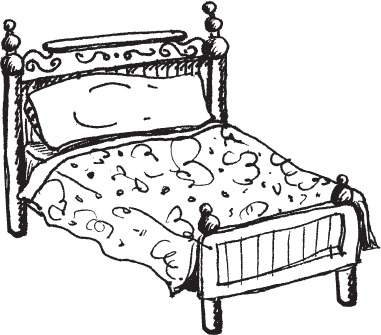
CURE A HANGOVER WITH THE “HAIR OF THE DOG THAT BIT YOU”
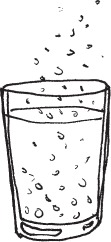
In other words another drink. This is effective, but only because it puts recovery on hold. Popular cures for the thumping head and sandpaper mouth have been invented in every age.
There are good reasons why alcohol produces hangovers. It causes dehydration; it reduces blood sugar levels; when processed by the liver it produces toxic by-products; and it contains chemicals, including methanol, that contaminate the system. Alcohol in drinks comes in two sorts, ethanol and methanol, which the liver tackles in that order. When it starts on the methanol it begins to produce its dire effects, releasing formic acid into the system. Having another drink puts the liver back into ethanol-processing mode, delaying the methanol effect.
Line your stomach; alcohol is absorbed more slowly if you eat before you drink.
Anything that raises blood sugar levels and adds water will help a hangover. This could be anything from a fatty bacon sandwich downed with large quantities of water or tea to paracetemol (acetaminophin) swallowed with a mashed banana and a pint of sweetened orange juice. A remedy from the 1880s onwards was John Pemberton’s tonic (destined to become Coca Cola) containing cocaine, caffeine and alcohol dissolved in caramel syrup and diluted with carbonated water.
The expression “hair of the dog” comes from the medieval belief that a cure for a dog bite was its burned hair inserted into the wound.
A saying that originates from the way in which the hair can apparently turn gray overnight, but whether it begins when you’re 30 or 60, gray hair is usually an inevitable family inheritance.
The prisoner in Byron’s poem “The Prisoner of Chillon” (1816) begins his story by asserting:
My hair is gray, but not with years,
Nor grew it white
In a single night,
As men’s have grown from sudden fears.
In fact, hair goes gray when pigment-producing cells in the hair follicles stop making melanin, the substance that gives hair its color. By the time you see they are gray the hairs are already dead, so there’s no point in pulling them out in the hope of something better! A severe shock or illness can make hair fall out, giving the impression that the hair has suddenly gone gray and, when it grows back, it can be paler.
Plants, particularly mature leaves of henna, Lawsonia inermia, have been used for at least 5,000 years to color the hair – and also for ceremonial decoration of the hands and nails. Some boiling water poured over a couple of handfuls of dried cornflowers (Centaurea cyanus), infused for a few hours and strained, makes a traditional herbal rinse that tints gray hair a delicate blue.
In men, hair and beard do not always turn gray simultaneously. “Graybeard” is a complimentary term for a wise old man – and also a word for a Flemish stoneware liquor pot named (in ridicule) for Cardinal Bellarmine who lived from 1542 to 1621.
AN APPLE A DAY KEEPS THE DOCTOR AWAY
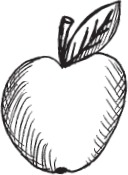
A 19th-century saying that may have arisen because no other fruit is cultivated and eaten in more countries of the world. Like other fruit, apples do you good because, among other things, they are rich in vitamins and fiber.
Apples promote a healthy circulation and immune system because they contain vitamin C and (in their skins) flavonoids, both antioxidants that also help keep arteries clear of clogging cholesterol. The soluble fiber they contain helps to cure constipation and their plant sugar fructose, metabolized more slowly than glucose, provides sustained energy. To make a “cooling drink for sick persons,” Enquire Within in the 1890s recommended “a tart apple well baked and mashed, on which pour a pint of boiling water. Beat up, cool and strain. Add sugar if desired.”
That a favored person is the “apple of your eye” comes from Psalm 17: “Guard me like the apple of your eye; hide me in the shadow of your wings, from the wicked who do me violence…”
But an apple a day also “keeps the dentist in pay.” For although eating a crunchy apple scrapes plaque-forming bacteria off the teeth, acids in the fruit pulp soften tooth enamel while the sugars provide ready sustenance for the microbes of decay.
Upon reaching the New World, the Pilgrim Fathers planted apples as one of their first crops. Johnny Appleseed was the nickname for John Chapman, born in Leominster, Massachusetts, on September 26, 1774. From about 1800, he collected seeds and planted them across the continent, creating nurseries from the East Coast to Ohio and Indiana.
Because fats are more packed with calories than other foods, eating them to excess can help pile on the pounds. But when food was scarce, plumpness was a sign of affluence and, in women like those depicted by the Flemish painter Sir Peter Paul Rubens in “The Three Graces” (1639), a mark of sensuality.
We enjoy eating fats because they not only give food a good flavor but impart a smooth texture that makes it slip down easily – the crucial difference between dry bread and bread and butter, or old-fashioned bread and dripping (the solidified fat from a roast joint). And no matter whether they are “good” unsaturated fats, like olive oil, or “bad” saturated fats from animal products (the ones linked to heart disease), all pure fats supply us with about 250 kilocalories per ounce (9 calories per gram). By comparison, even pure carbohydrate such as sugar contains only about 111 calories per ounce (4 calories per gram).
Weight Watchers was founded in 1961 by Jean Nidetch, an overweight New York City housewife who initially formed a support group with her friends for mutual advice and encouragement.
When it comes to weight the simple truth is that if you take in more calories than you burn then your body stores the excess as fat. That obesity is a problem today is exemplified by the fact that while in 1900 Americans obtained on average 30 percent of their daily calories from fat, a century later it was at least 40 percent – between six and eight times as much as the body needs for essential jobs such as cell maintenance and repair.

What grandmother knew by instinct, science confirms. Laughter boosts immunity, stimulates the brain and reduces stress. The old jokes are, it seems, still the best, and it is said that no man ever distinguished himself who could not bear to be laughed at.
Laughing is so good for you that laughter therapy is fast being developed as a form of treatment for people with chronic and long-term illnesses such as diabetes, multiple sclerosis, myalgic encephalomyelitis and cancer. Laughter increases the production of mood-enhancing endorphins, lowers blood levels of the stress hormone cortisol and improves immune system performance.
According to the old proverb, if you laugh before breakfast you will cry before supper.
When we laugh we not only exercise our lungs and vocal cords but also unlock our inhibitions, making it easy to mock the plights of characters such as the puppets Punch and Judy. Punch who, though wicked, manages to escape from the Devil (symbolized by the crocodile) but not from his nagging wife, is based on the Italian character Pulcinello from the 16th-century commedia dell’arte.
Laughing gas (nitrous oxide), named from its effect on patients before they drifted into unconsciousness, was used to numb the pain of dentistry from the late 19th century, although the chemist Sir Humphrey Davy had suggested its use as an anesthetic nearly a century earlier.
YOU SHOULD BREAKFAST LIKE A KING... AND DINE LIKE A PAUPER
The first meal of the day, the end of the night’s “fast,” is the chance to replenish energy supplies. And there is some evidence that people who eat a good breakfast have less trouble controlling their weight than those who don’t.
In studies of eating behavior, researchers discovered that many (but not all) thin folks who eat breakfast consume fewer calories for the rest of the day than those who do not and, as a bonus, find it easier to stick to a calorie-controlled diet. Other trials confirm that high-fiber foods eaten early in the day are effective at taming hunger and that giving children wholewheat cereal or porridge for breakfast seems to be a good way of preventing them from gaining excess weight.
Kedgeree – a curried dish of smoked fish, rice and hard boiled eggs – was a popular import to Britain in the days of the Raj. The original breakfast dish khichri, made from mung beans and rice, has been made and enjoyed for centuries.
On the farm, milk and eggs, direct from dairy and henhouse, were the natural, readily available breakfast choices. Over the years other foods became breakfast favorites; in the grand 19th-century home bacon, kidneys (often devilled), kippers, kedgeree, sausages, tomatoes and mushrooms would be on offer for guests, served in the dining room or a separate breakfast room.
Compared with porridge (see “Always Add Salt to Porridge” on page 102), ready-to-eat breakfast cereals are newcomers to the breakfast table. Brothers Will and John Harvey Kellogg marketed their first packets of cornflakes in 1898, backed up by a powerful health message.
Up to a point, but for most people with ulcers in the stomach or duodenum – and in the mouth – the primary cause is infection. But stress, because it can lower your immunity, doesn’t help.
In the intestine, it is the bacterium Helicobacter (H.) pylori that is the culprit in forming ulcers. It is estimated that half the population harbor it, probably from childhood, although only a fifth of these actually develop ulcers. In a peptic ulcer, which can affect the esophagus, stomach or duodenum, the lining of the intestine is attacked and eroded by acid juices.
Although the ulcer-prone are advised to avoid irritants such as tobacco smoke, alcohol and spices, they no longer face the old treatments of bed rest, bland food and “free administration of bismuth and alkalis.”
Antibiotics, combined with drugs to inhibit acid production – or to neutralize it, once secreted – are the conventional treatments for peptic ulcers, but there are many traditional remedies. These include licorice root, which increases the secretion of the protective, sticky substance mucin in the gut, and “miraculous” mastic gum, which has been used to treat digestive complaints for over 3,000 years and is produced from the tree Pistachia lentiscus, which grows exclusively on the Greek island of Chios. The bonus of mastic gum is that it also deals a knockout blow to the Herpes simplex viruses that cause mouth ulcers and cold sores.
